Fire Whirls
Fire whirls are vortical columns with a concentrated burning core. Observed lengths vary from approximately 0.1m in small experiments to tens of meters in wildland fires. An extreme example of their destructive power is the fire whirl that followed the 1923 Tokyo earthquake, which incinerated 38,000 people in less than fifteen minutes. Despite significant research efforts, the current understanding of the flow structure and dynamics of fire whirls, including the reasons for their dramatic flame-lengthening effect and increased burning rate, is far from complete. Our research contributes to the needed understanding by investigating fire whirls through a combination of small-scale lab experiments, theoretical analysis and numerical computations. The work is supported by the National Science Foundation through grant no. 1916979.
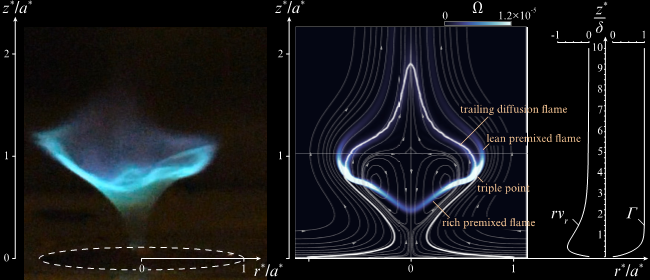
A blue whirl in the lab (left) and its corresponding numerical description (right) .
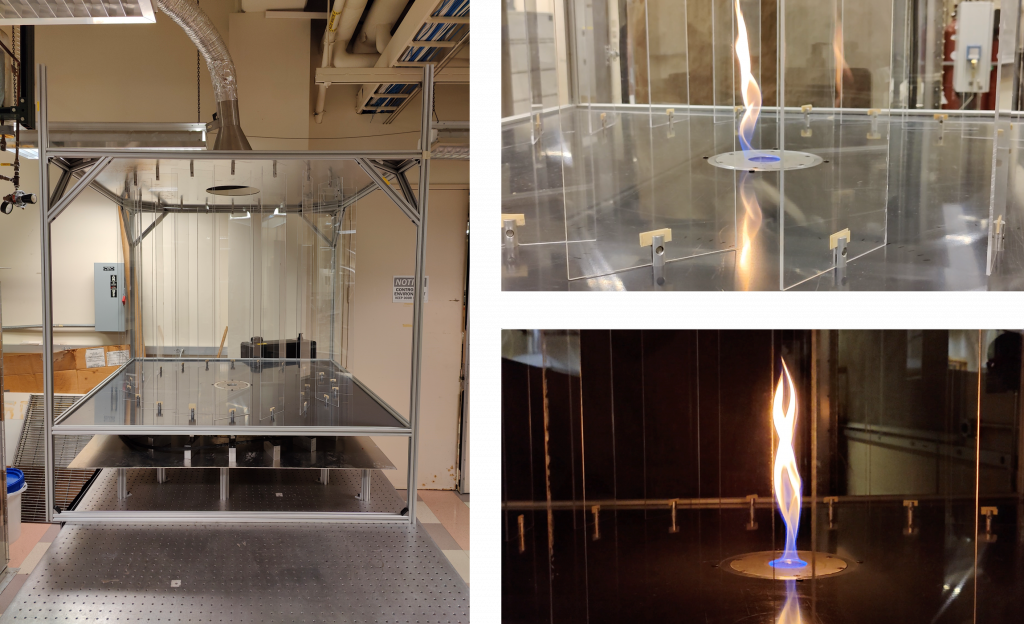
Our fire whirl experimental facility.
Related publications
-
- Observed dependence of characteristics of liquid-pool fires on swirl magnitude
W. Coenen, E. J. Kolb, A.L. Sánchez, F. A. Williams, Combust. Flame, 205:1-6 (2019). [DOI] - A model for the constant-density boundary layer surrounding fire whirls
A. D. Weiss, P. Rajamanickam, W. Coenen, A. L. Sánchez, F. A. Williams, J. Fluid Mech., 900:A22 (2020). [DOI] - Numerical description of axisymmetric blue whirls over liquid-fuel pools
J. Carpio, W. Coenen, A.L. Sánchez, E.S. Oran, F.A. Williams, Proc. Combust. Institute, 38:2041-2048 (2021). [DOI]
- Observed dependence of characteristics of liquid-pool fires on swirl magnitude
Compressible flow problems in high-speed propulsion application
Shock waves and detonations are ubiquitous in supersonic propulsion applications, including scramjets, ram accelerators and oblique detonation wave engines. The strongly nonlinear character of the flow hinders associated experimental and computational investigations. A deeper fundamental understanding of the interactive hydrodynamic coupling between the chemical heat release and the shock is needed to guide practical designs. Our work has focused on analyses of detonation structure and dynamics as well as interactions of oblique shocks and laminar shear layers leading to diffusion-flame ignition.
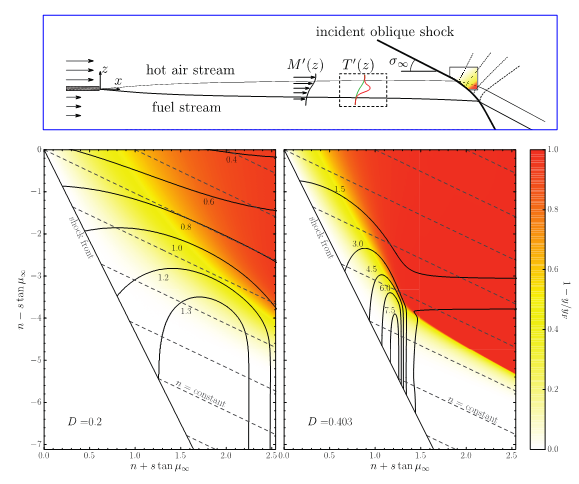
Shock-wave interaction with a fuel-air mixing layer (upper panel) with a detailed view of the resulting ignition kernels (lower panels).

Schematic view of wedge-induced transition from a chemically frozen oblique shock wave to an oblique detonation wave (left) and associated postshock distributions of dimensionless temperature as obtained for hydrogen–air chemical kinetics (middle and right plots).
Related publications
-
- Diffusion-flame ignition by shock-wave impingement on a supersonic mixing layer
C. Huete, A. L. Sánchez, F. A. Williams, J. Urzay, J. Fluid Mech., 784 74{108 (2015). [DOI] - Weak-shock interactions with transonic laminar mixing layers of fuels for high-speed propulsion
C. Huete, J. Urzay, A. L. Sánchez, F. A. Williams, AIAA J., 54 962{975 (2016). [DOI] - Interaction of oblique shocks and laminar shear layers
D. Martínez-Ruiz, C. Huete, A. L. Sánchez, F. A. Williams, AIAA J., 56 1023{1030 (2018). [DOI] - Theory of weakly exothermic oblique detonations
D. Martínez-Ruiz, C. Huete, A. L. Sánchez, F. A. Williams, AIAA J., 58 236-242 (2020). [DOI] - Wedge-induced oblique detonations with small heat release
A. Domínguez-González, D. Martínez-Ruiz, L. Scotzniovsky, A. L. Sánchez, F. A. Williams, AIAA J., 60:411-422 (2022). [DOI]
- Diffusion-flame ignition by shock-wave impingement on a supersonic mixing layer
Hydrogen Combustion
Our motivation for investigating the combustion of hydrogen falls into two broad categories, one concerning its utilization and the other concerning its safety. From the viewpoint of utilization, there is increasing interest in hydrogen usage for power production. Because of their environmental and economic benefits, hydrogen-fueled gas turbines are bound to play an important role in foreseeable carbon-free energy-production scenarios. Manufactures are moving from systems fueled by natural gas to new designs involving hydrogen addition to carbon-containing or carbon-free fuels, such as ammonia, or simply using only hydrogen. Along with its increasing utilization come increasing safety concerns about hydrogen. It is much easier to ignite hydrogen than most other fuels, and its range of flammability is considerably broader. Prevention of hydrogen fires may be deemed essential. It thus becomes of paramount importance to ascertain accurately the flammability limits of hydrogen mixtures under different circumstances. Complications arise from the fact that the limits may be appreciably different in spacecraft, for example, than on Earth. Safety aspects thus warrant extensive investigation for hydrogen. The work was supported US AFOSR Grant No. FA9550- 20-0431.
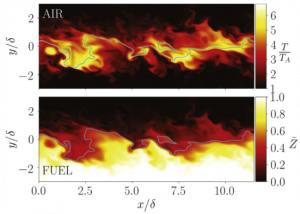
A hydrogen-air nonpremixed flame exhibiting superadiabatic temperatures as a result of differential diffusion .
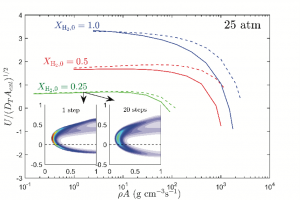
The variation with strain of the velocity a triple flame propagating along a two-dimensional mixing layer separating counterflowing streams of air and hydrogen diluted with nitrogen.
Related publications
-
-
- Effects of differential diffusion on nonpremixed-flame temperature
A. Almagro, O. Flores, M. Vera, A. Liñán, A. L. Sánchez, F. A. Williams, Proc. Combust. Institute, 37 1757–1766 (2019). [DOI] - A one-step reduced mechanism for near-limit hydrogen combustion with general stoichiometry
D. Fernández-Galisteo, A.D. Weiss, A. L. Sánchez, F. A. Williams, Combust. Flame, 208 1–4 (2019). [DOI] - Near-limit H2-O2-N2 combustion in nonpremixed counterflow mixing layers
J. Carpio, P. Rajamanickam, A. L. Sánchez, F. A. Williams, Combust. Flame, 216 426–438 (2020). [DOI] - Unexpected performance of systematically derived one-step chemistry in describing rich hydrogen-air pulsating flames
A. L. Sánchez, J. Carpio, F. A. Williams, Combust. Flame, 241 112068 (2022). [DOI] - Systematically derived one- step kinetics for hydrogen-air gas-turbine combustion
J. Carpio, B. Li, D. Fernández-Galisteo, A. L. Sánchez, F. A. Williams, Combust. Flame, 250:112633 (2023). [DOI]
- Effects of differential diffusion on nonpremixed-flame temperature
-
Reacting jets: structure, stability and dynamics
Jets are key elements in many problems of interest in engineering. Our motivation stems mainly from combustion applications involving variable-density flows at moderately large values of the Reynolds number. The work is supported by the National Science Foundation through grant no. 1916979.
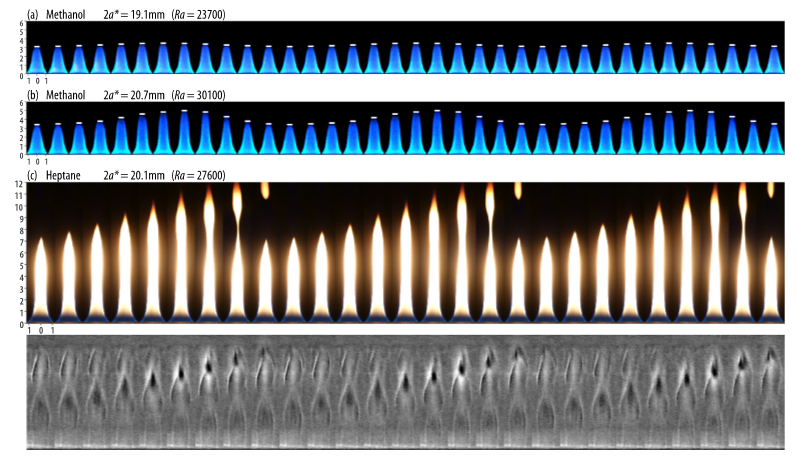
Three puffing cycles for supercritical (a, b) methanol (titanium wall), and (c) heptane (brass wall) flames. In the first two visible sequences, artificially imposed horizontal bars are marked at the top of the flame to track the flame-height oscillations.
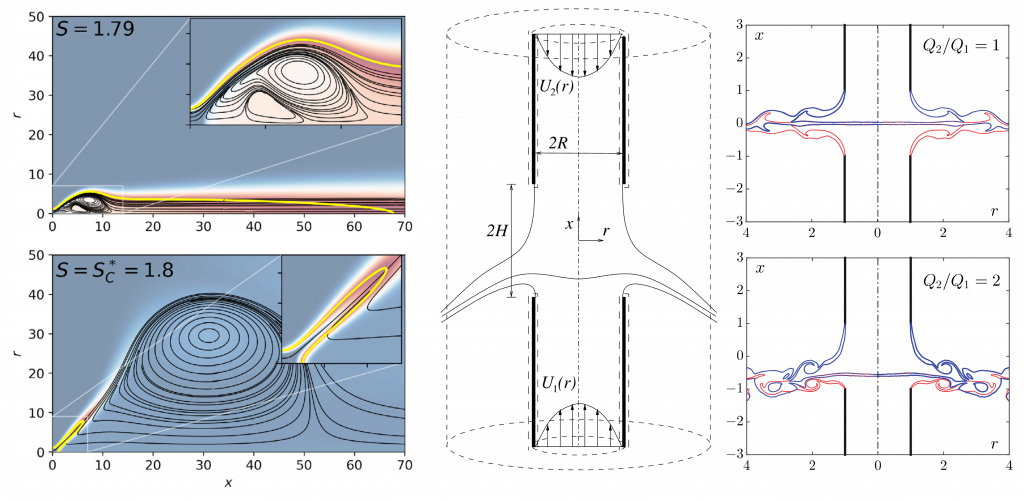
(Left) Vortex breakdown in a reactive jet: transition from bubble to cone. (Right) Counterflowing jets at moderately large Reynolds numbers.
Related publications
-
-
-
- Diffusion-flame flickering as a hydrodynamic global mode
D. Moreno-Boza, W. Coenen, A, Sevilla, J. Carpio, A. L. Sánchez, A. Liñán, J. Fluid Mech., 798 997–1014 (2016). [DOI] - Aerodynamics of planar counterflowing jets
J. Carpio, A. Liñán, A. L. Sánchez, F. A. Williams, Combust. Flame, 177 137–143 (2017). [DOI] - Aerodynamics of axisymmetric counterflowing jets
A. D. Weiss, W. Coenen, A. L. Sánchez, J. Fluid Mech., 821 1–30 (2017). [DOI] - On the critical conditions for pool-fire puffing
D. Moreno-Boza, W. Coenen, J. Carpio, A. L. Sánchez, F. A. Williams, Combust. Flame, 192 426–438 (2018). [DOI] - Swirling flow induced by jets and plumes
W. Coenen, P. Rajamanickam, A. D. Weiss, A. L. Sánchez, F. A. Williams, Acta Mech., 230 2221–2231 (2019). [DOI] - Vortex breakdown in variable- density gaseous swirling jets
B. Keeton, J. Carpio, K. Nomura, A. L. Sánchez, F. A. Williams, J. Fluid Mech., 936 A1 (2022). [DOI] - Vortex breakdown in swirling Burke-Schumann flames
B. Keeton, K. Nomura, A. L. Sánchez, F. A. Williams, Proc. Combust. Institute, 39(2), 1935-1645 (2023). [DOI] - A computational investigation of swirl-number and Damkohler-number effects on non-premixed laminar swirling jet flames
B. Keeton, K. Nomura, A. L. Sánchez, F. A. Williams, Combust. Flame, 258, 113075 (2023) [DOI]
- Diffusion-flame flickering as a hydrodynamic global mode
-
-